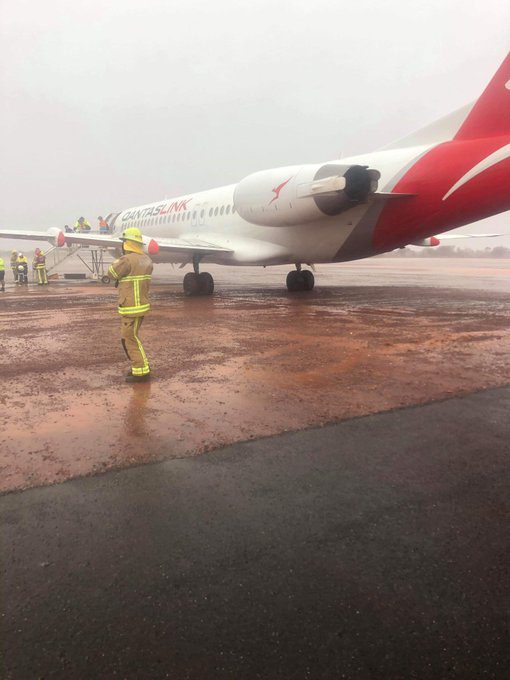Imagine a plane load of mineworkers hurtling down a runway with the plane unable to stop. It finally runs off the end of the tarmac and comes to stop in the mud off the end of the runway.
While it sounds like an episode of Mining Boom, the incident was real and reportedly scared the wits out of a few miners on their way into Newman yesterday. The technical term used by investigators is a ‘runway excursion.‘ But it’s an excursion that the FIFO mineworkers would have rather not have had and, ultimately should not have to face as part of their job.
Qantas Link QF2650 left Perth at 5.37 am and arrived at Newman at around 7.23 am yesterday in the midst of bad weather from Cyclone Blake. The problem was there was just a wee bit of rain and wind on arrival in Newman.
The ATSB has confirmed it is “investigating a runway overrun involving Fokker F100, VH-NHY, at Newman Airport, Western Australia, on 9 January 2020.”
The ATSB said that “During landing, the aircraft overran the runway, stopping approximately 100 metres beyond the runway threshold. There were no injuries to crew or passengers.”
It said, “The evidence collection phase of the investigation will include reviewing flight data, interviewing the flight crew, reviewing operational information and examining the runway conditions at the time.”
READ RELATED
A Qantas spokesperson confirmed “The aircraft has come to a complete stop in what’s called the runway end safety area.
Flights in and out of Newman yesterday were canceled while the aircraft was removed and checked by maintenance engineers.
Qantaslink confirmed “We have commenced an internal investigation to determine how this occurred and have reported the incident to the ATSB.
We apologise to impacted customers and are working to re-accommodate them as quickly as possible.”
Previous incidents for aging Fokker F100 fleets
According to records, It’s not the first time that the same aircraft has been involved in an incident. In 2016 a low hydraulic pressure and smoke and fumes in the cabin resulted in the aircraft being evacuated on arrival at the end of the taxiway in Perth.
Additionally, there have been a range of incidents involving Fokker F100 operations across a range of carriers including an engine failure in July 2019 (Geraldton to Perth) (VH-FWI), a loss of cabin pressure in June 2016 on a flight from Christmas Creek to Perth (VH-NHF), and engine failure in July 2018 (VH-UQC) from Brisbane to Mount Isa, a fuel-related emergency in June 2015 from West Angelas to Perth. There also have been several bird strike incidents at Australian airports over several years.
The Fokker F100 aircraft has been a staple for mining FIFO transport operations in Australia with QantasLink, Virgin and Alliance Airlines all operating aging fleets. QantasLink operates 17 Fokker 100s through its’ Perth-based Network Aviation subsidiary.
QantasLink’s fleet age is 26.5 years, Alliance Airlines operate a fleet with an average age of 28 years and Virgin Regional with an average age of 27.6 years according to aircraft facts supplied by Planespotters.net website.
The first Fokker F100 aircraft was produced in 1986 and the global production of the aircraft ceased in 1997.
Should mining companies be closely examining FIFO air safety?
While AMSJ understands that tens of thousands of hours are flown by mining personnel across the country each year without incident, the outcomes of an aircraft crash are seldom favorable. In any risk matrix, the consequence of the loss of a planeload of miners in an aircraft incident would be a highly catastrophic event and one that demands an appropriate response from the industry.
Appreciating that the probabilities of an incident remain low, the past evidence of mining-related aircraft incidents could be well worth a further review by mine company management and safety practitioners across the industry. Here are just a few mining-related aircraft safety incidents to whet the appetite!
- In May 2019, a Cessna Aircraft Company 210M (VH-SUX) operated by Thomson Aviation, reportedly departed Mount Isa Airport for an aerial geological survey flight contracted by the Queensland Department of Natural Resources & Mines. The aircraft crashed killing two pilots. The incident is currently under investigation.
- Ten months ago a helicopter crashed during lifting operations at the Carrapateena mine construction site killing the pilot.
- In February 2006, a Robinson Helicopter Company R44 ‘Astro’ helicopter (VH-HBS) was conducting aerial survey flights approximately 100 km to the north of Mt Isa from the Gunpowder mine airstrip when it crashed when it was overloaded.
- Of course one of the most notable incidents was in June 2010, when Ken Talbot and the entire board of Sundance Resources died on a chartered flight between Yaoundé, Cameroon and the Congo. The incident resulted in a substantial impact on the company and its’ operations.
- The Sons of Gwalia ‘Ghost Flight’ aircraft incident in 2000 (see Final Report) killed seven mine staff and the pilot when the Beechcraft Super King Air 200 systems failed to warn pilots of hypoxia that resulted in all personnel in the aircraft passing out from lack of oxygen supply.
Recognising that risks with aircraft operations in mining exist should form part of an effective corporate safety plan. Just because it’s off-site, provided by an airline contractor or under the jurisdiction of the ATSB doesn’t mean it can’t affect mining operational performance.
It has in the past..and if not managed effectively, aircraft safety may haunt the mining industry again.
Image: Twitter @KR_1973
Read more Mining Safety News














Add Comment